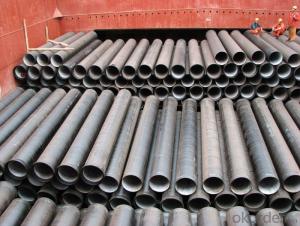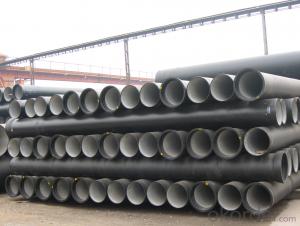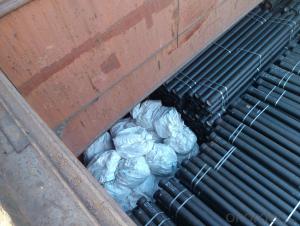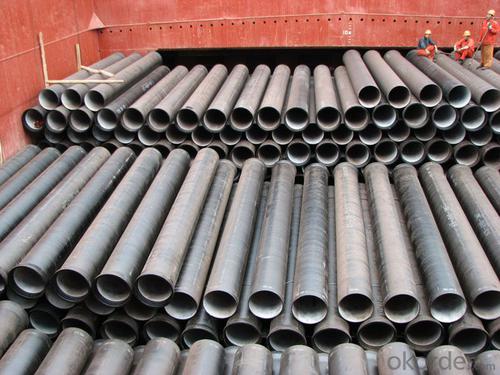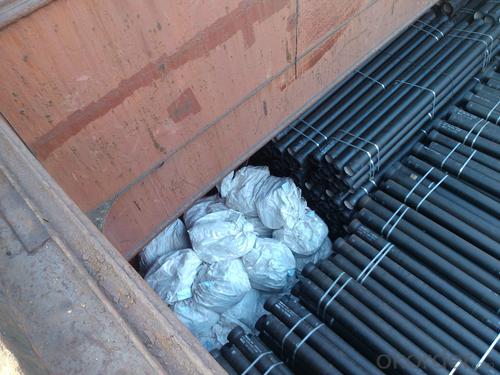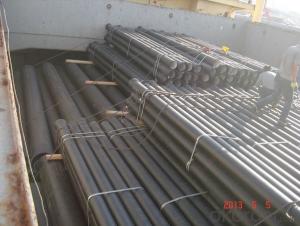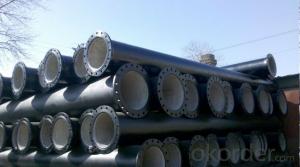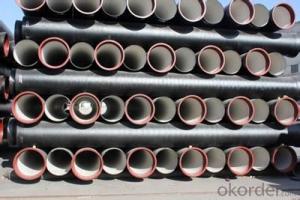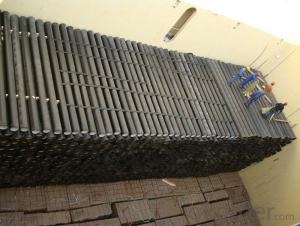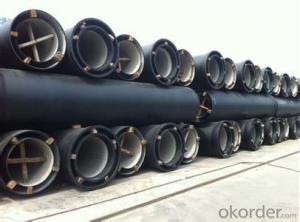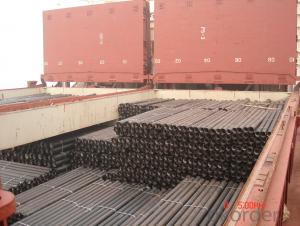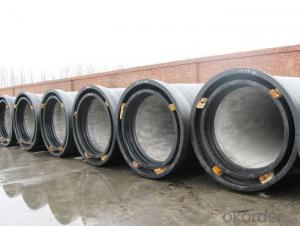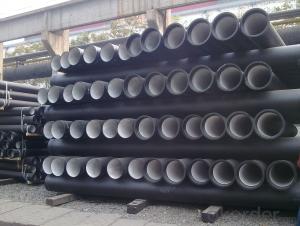DUCTILE IRON PIPE DN600 K8
- Loading Port:
- China Main Port
- Payment Terms:
- TT OR LC
- Min Order Qty:
- -
- Supply Capability:
- -
OKorder Service Pledge
OKorder Financial Service
You Might Also Like
Specification:
1) The standard of pipe: ISO2531:1998, K9
2) Effective length: 6m
3) Inner cement line: Portland cement line as per ISO4179
4) Zinc coating: at least 130g/m2 as per ISO8179
5) Bitumen painting: at least 70um as per ISO8179
6) With 100% quantity of NBR ring, or SBR ring, or EPDM ring as per ISO4633
7) DN80mm-800mm
8) High strength, lighter than grey iron, good corrosion resistance, no furring, small flow resistance, easy fixing, long life tome about 100 yeas
9) Produced by Hangzhou chunfeng machine
10) Checked by automatic inspection equipment
11) Composition:
Chemical composition | | | | |||
Chemical composition | Ductile Cast Iron Pipe (%) | Grey iron pipe (%) | Steel pipe (%) | | | |
C | 3.5-4.0 | 3.2-3.8 | 0.1-0.2 | | | |
Si | 1.9-2.6 | 1.4-2.2 | 0.15-0.4 | | | |
Mn | 0.15-0.45 | 0.4-0.6 | 0.3-0.6 | | | |
P | ≤0.06 | ≤0.3 | 0.02-0.03 | | | |
S | ≤0.02 | ≤0.1 | 0.02-0.03 | | | |
Mg | 0.03-0.06 |
|
| | | |
12) Feature:
Mechanical properties | | | | |||
| Ductile Cast Iron Pipe | Grey Iron Pipe | Steel Pipe | | | |
Tensile Strength(Mpa) | ≥420 | 150-260 | ≥400 | | | |
Yield Strength(Mpa) | ≥300 | No Confirmation | No Confirmation | | | |
Bending Strength(Mpa) | ≥590 | 200-360 | ≥400 | | | |
Elongation (%) | ≥10 | Neglected | ≥18 | | | |
Brinell Hardness(HBS) | ≤230 | ≤230 | About 140 | | | |
13) T type mechanical joint
14) Packing: in bulk or container
- Q: The role of chromium in nodular cast iron
- In order to further understand the mechanism of chromium in ductile iron, the application of electronic scanning and other test means, from chrome crystal structure, crystallization, solidification, heat treatment transformation principle, further study on the mechanism of chromium in ductile iron.
- Q: Can ductile iron pipes be used for agricultural applications?
- Yes, ductile iron pipes can be used for agricultural applications. Ductile iron pipes are known for their durability, strength, and corrosion resistance, making them suitable for various agricultural applications such as irrigation systems, water supply networks, and drainage systems.
- Q: What is the difference between spheroidal graphite cast iron QT400-15 and QT400-15A? What does the A mean later?
- The front is the material grade, and the back of the A should have special requirements.
- Q: What's the advantage of FCD50 ductile iron?
- Ductile cast iron pipes are called ductile iron pipes.
- Q: What is the expected deflection limit of ductile iron pipes?
- Several factors, including pipe diameter, wall thickness, and soil conditions, determine the expected deflection limit of ductile iron pipes. According to industry standards, it is recommended that ductile iron pipes used for underground installations should not exceed a deflection limit of 2%. In other words, the maximum allowable deflection would be 2% of the pipe's diameter. It is important to be aware that surpassing the deflection limit can result in various issues, such as reduced flow capacity, higher chances of pipe failure, and compromised structural integrity. Therefore, it is crucial to carefully consider and adhere to the suggested deflection limits when designing and installing ductile iron pipes to ensure their long-term performance and reliability.
- Q: Ductile iron pipe is flexible pipe or rigid pipe
- The flexible tube and you say should refer to the common steel pipe and seamless steel pipe, because the two are by the simple method according to the needs and the deformation, in other words, ductile iron is cast out without deformation.
- Q: How does ductile iron pipe perform in areas with high soil compaction?
- Areas with high soil compaction benefit greatly from the exceptional performance of ductile iron pipe. One of its key advantages lies in its high strength and durability, enabling it to withstand heavy loads and pressures. In regions where soil compaction is prevalent, leading to ground movement and settling, ductile iron pipe's superior structural integrity guarantees its intactness and effective handling of stress. Moreover, ductile iron pipe exhibits excellent resistance to corrosion, which is especially crucial in areas with high soil compaction. The compacted soil often contains elevated levels of moisture or chemicals that may accelerate the corrosion process. Ductile iron's inherent resistance to corrosion ensures the pipe maintains its integrity over time, even in challenging soil conditions. Flexibility is another advantage of ductile iron pipe. This material possesses a high degree of flexibility, enabling it to absorb and distribute external loads more efficiently. In areas with high soil compaction, where the ground may shift or settle, ductile iron's flexibility minimizes the risk of pipe failure or damage. Additionally, ductile iron pipe boasts a smooth interior surface, enhancing its hydraulic performance. In regions with high soil compaction, where space for proper compaction around the pipe may be limited, the smooth interior reduces the likelihood of sediment buildup or clogging, ensuring efficient water flow. Overall, ductile iron pipe proves to be an excellent solution for areas with high soil compaction. Its strength, corrosion resistance, flexibility, and hydraulic performance establish it as a reliable and durable choice capable of withstanding the challenges presented by compacted soils.
- Q: How are ductile iron pipes different from other types of pipes?
- DI pipes, also called ductile iron pipes, possess unique properties and are manufactured differently from other pipe types. They are specifically designed to withstand high-pressure systems and offer exceptional strength and durability, setting them apart from PVC, steel, or concrete pipes. One significant distinction lies in the material used. DI pipes are made from a type of cast iron containing additional elements like carbon and silicon, which give them remarkable strength and flexibility. This composition enables DI pipes to handle high-pressure systems, making them suitable for applications requiring reliable water supply, such as water mains, sewer systems, and industrial pipelines. Another distinguishing feature of DI pipes is their ability to endure external loads and pressure. They possess high tensile strength, enabling them to bear heavy loads without cracking or breaking. This property makes them ideal for underground installations, where they can withstand the weight of soil, traffic, and other external factors. Furthermore, DI pipes exhibit excellent corrosion resistance. They are coated with a protective layer, typically through cement lining, which safeguards against rust and corrosion caused by the elements, chemical reactions, or transported fluids. This corrosion resistance significantly extends the pipes' lifespan, reducing maintenance and replacement costs over time. Additionally, DI pipes offer great flexibility. They are renowned for their ductility, meaning they can deform under stress without fracturing, making them less prone to cracks and leaks. This inherent flexibility allows them to withstand ground movement and seismic activities, ensuring a safe and reliable water distribution system. Regarding installation, DI pipes are relatively easy to handle due to their lighter weight compared to materials like concrete or steel. They are also available in various lengths and diameters, making them adaptable to different project requirements. In conclusion, DI pipes distinguish themselves through their exceptional strength, resilience, corrosion resistance, and ease of installation. These properties make them the preferred choice for numerous infrastructure projects, where reliability and longevity are critical factors.
- Q: How are ductile iron pipes protected against stray electrical currents?
- To safeguard water and sewer systems, ductile iron pipes are shielded from stray electrical currents through a technique called cathodic protection. This process entails the application of a low-voltage direct current (DC) to the pipes, generating a defensive electrical field around them. To achieve cathodic protection, sacrificial anodes or impressed current systems are installed near the ductile iron pipes. Sacrificial anodes, composed of a more electrically active metal like zinc or magnesium, are connected to the pipes and act as the electrical current source. Over time, these anodes corrode, sacrificing themselves to shield the pipes from corrosion caused by stray electrical currents. However, impressed current systems utilize an external power source to supply the protective electrical current. Rectifiers are employed to convert alternating current (AC) to direct current (DC), which is then administered to the pipes through anodes. This approach provides greater control over the amount of current applied, ensuring optimal protection. In both scenarios, the electrical current flowing through the sacrificial anodes or impressed current systems establishes a protective barrier around the ductile iron pipes. This barrier impedes the flow of stray electrical currents through the pipes, thus diminishing the risk of corrosion and prolonging the infrastructure's lifespan. Regular monitoring and maintenance of the cathodic protection system are crucial to uphold its efficacy. This involves inspecting the anodes, assessing the levels of electrical current, and making any necessary adjustments or replacements to maintain the desired level of protection. To summarize, cathodic protection is a dependable and widely utilized method for safeguarding ductile iron pipes against stray electrical currents. By preserving the integrity and longevity of water and sewer systems, it plays a vital role in ensuring their functionality.
- Q: What does ductile iron pipe "ND200" mean?
- The nominal pipe diameter and the inner diameter and the outer diameter were not equal, for example: the nominal diameter of 100MM seamless steel pipe 102*5, 108*5 several, 108 for the outer diameter of pipes, 5 said that the wall thickness of the tube, therefore, the pipe diameter (108-5-5 = 98MM), but it is not completely equal to pipe diameter minus two times the wall thickness difference, it can be said that the nominal diameter is close to the diameter, but not equal to the diameter of a pipe diameter specifications on the design drawings, so we use the nominal diameter, the purpose is to determine according to the nominal diameter pipe, flange and gasket structure and size connecting dimensions, nominal diameter is represented by the symbol DN, if the diameter of said in the design drawings, piping specifications should also make the table, show that the nominal diameter of a pipe wall thickness.
Send your message to us
DUCTILE IRON PIPE DN600 K8
- Loading Port:
- China Main Port
- Payment Terms:
- TT OR LC
- Min Order Qty:
- -
- Supply Capability:
- -
OKorder Service Pledge
OKorder Financial Service
Similar products
Hot products
Hot Searches
Related keywords
